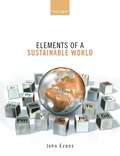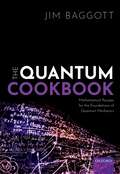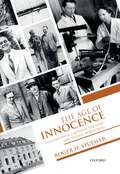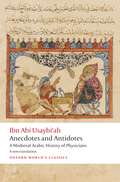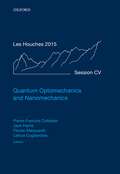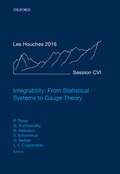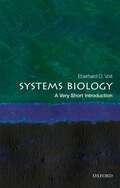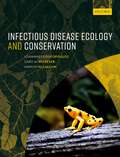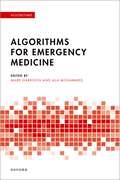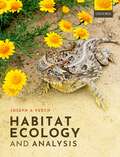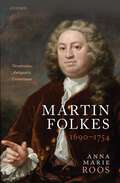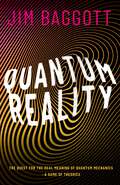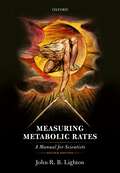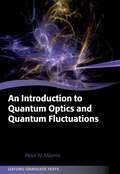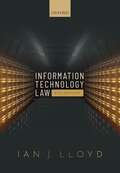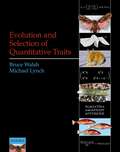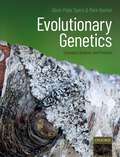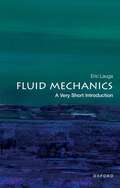- Table View
- List View
Elements of a Sustainable World
by John EvansWe have 118 known chemical elements as our palette in our context of sustaining our world. Our context is considered in terms of the four spheres of the ancient world: Earth, Air, Fire and Water. This book shows how chemical principles can be used to understand the pressures on our world, spanning from greenhouse emissions through freshwater supplies to energy generation and storage. The supply of the chemical elements is key to their contribution to alleviating these pressures. Most synthetic and radioactive elements are not available in sufficient supply to contribute in this. Some solutions, such as wind turbines, batteries, fuel cells and automotive exhaust remediation pose questions about sustainable supplies of critical elements. With an eye on the target of the IPCC of capping the temperature anomaly to 1.5 oC (RCP2.6), options for carbon capture and storage, and the generation of energy and element supply from the sea are assessed. The consequences of the escape of plastics and pharmaceuticals into the wider environment for water integrity are also considered. This book is designed around providing a one semester course for students who have entered at least the second level of university chemistry. It provides explanations and entries to current environmental issues. For students of environmental science, it provides an understanding of the chemical principles underpinning the causes and possible solutions to these issues. Each chapter has a set appropriate study questions. A study guide is available for the book.
The Quantum Cookbook: Mathematical Recipes for the Foundations of Quantum Mechanics
by Jim BaggottQuantum mechanics is an extraordinarily successful scientific theory. But it is also completely mad. Although the theory quite obviously works, it leaves us chasing ghosts and phantoms; particles that are waves and waves that are particles; cats that are at once both alive and dead; lots of seemingly spooky goings-on; and a desperate desire to lie down quietly in a darkened room. The Quantum Cookbook explains why this is. It provides a unique bridge between popular exposition and formal textbook presentation, written for curious readers with some background in physics and sufficient mathematical capability. It aims not to teach readers how to do quantum mechanics but rather helps them to understand how to think about quantum mechanics. Each derivation is presented as a 'recipe' with listed ingredients, including standard results from the mathematician's toolkit, set out in a series of easy-to-follow steps. The recipes have been written sympathetically, for readers who - like the author - will often struggle to follow the logic of a derivation which misses out steps that are 'obvious', or which use techniques that readers are assumed to know.
The Age of Innocence: Nuclear Physics between the First and Second World Wars
by Roger H. StuewerThe two decades between the first and second world wars saw the emergence of nuclear physics as the dominant field of experimental and theoretical physics, owing to the work of an international cast of gifted physicists. Prominent among them were Ernest Rutherford, George Gamow, the husband and wife team of Frédéric and Irène Joliot-Curie, John Cockcroft and Ernest Walton, Gregory Breit and Eugene Wigner, Lise Meitner and Otto Robert Frisch, the brash Ernest Lawrence, the prodigious Enrico Fermi, and the incomparable Niels Bohr. Their experimental and theoretical work arose from a quest to understand nuclear phenomena; it was not motivated by a desire to find a practical application for nuclear energy. In this sense, these physicists lived in an 'Age of Innocence'. They did not, however, live in isolation. Their research reflected their idiosyncratic personalities; it was shaped by the physical and intellectual environments of the countries and institutions in which they worked. It was also buffeted by the political upheavals after the Great War: the punitive postwar treaties, the runaway inflation in Germany and Austria, the Great Depression, and the intellectual migration from Germany and later from Austria and Italy. Their pioneering experimental and theoretical achievements in the interwar period therefore are set within their personal, institutional, and political contexts. Both domains and their mutual influences are conveyed by quotations from autobiographies, biographies, recollections, interviews, correspondence, and other writings of physicists and historians.
Anecdotes and Antidotes: A Medieval Arabic History of Physicians (Oxford World's Classics)
by Ibn Abi Usaybi'ahTo my knowledge...no one...has ever written a comprehensive book dealing with physicians through the ages and recounting their history in a coherent fashion. So wrote Syrian physician Ibn Abi Usaybi'ah, circa 1243, as he embarked on the first world history of medicine ever attempted. Many physicians served at the royal courts of their time and were firmly part of the intellectual and cultural scene, where the ability to write stylishly and entertain one's peers in both prose and verse was the basis of social credibility. The work Ibn Abi Usaybi'ah created contains over 432 biographical accounts of physicians from those of ancient Greece, such as Galen, through Avicenna and Maimonides, to the author's own colleagues of the 13th century. As such, his work includes important accounts of medical activity in medieval hospitals. Through this book, a window opens not only on to the origins of the medical profession, but also into the truly multi-cultural, multi-religious world of the medieval Middle East. Anecdotes and Antidotes is an abridged version of this world history of medicine. It comprises 103 biographies of physicians and philosophers, organized geographically and chronologically, from the 4th century BC to the 13th century, and includes seminal Muslim, Christian and Jewish figures. It contains vital medical and historical information, as well as revealing the cultural values, interests and concerns of the literary and intellectual elite of the time.
Anecdotes and Antidotes: A Medieval Arabic History of Physicians (Oxford World's Classics)
by Ibn Abi Usaybi'ahTo my knowledge...no one...has ever written a comprehensive book dealing with physicians through the ages and recounting their history in a coherent fashion. So wrote Syrian physician Ibn Abi Usaybi'ah, circa 1243, as he embarked on the first world history of medicine ever attempted. Many physicians served at the royal courts of their time and were firmly part of the intellectual and cultural scene, where the ability to write stylishly and entertain one's peers in both prose and verse was the basis of social credibility. The work Ibn Abi Usaybi'ah created contains over 432 biographical accounts of physicians from those of ancient Greece, such as Galen, through Avicenna and Maimonides, to the author's own colleagues of the 13th century. As such, his work includes important accounts of medical activity in medieval hospitals. Through this book, a window opens not only on to the origins of the medical profession, but also into the truly multi-cultural, multi-religious world of the medieval Middle East. Anecdotes and Antidotes is an abridged version of this world history of medicine. It comprises 103 biographies of physicians and philosophers, organized geographically and chronologically, from the 4th century BC to the 13th century, and includes seminal Muslim, Christian and Jewish figures. It contains vital medical and historical information, as well as revealing the cultural values, interests and concerns of the literary and intellectual elite of the time.
Quantum Optomechanics and Nanomechanics: Lecture Notes of the Les Houches Summer School: Volume 105, August 2015 (Lecture Notes of the Les Houches Summer School #105)
The Les Houches Summer School in August 2015 covered the emerging fields of cavity optomechanics and quantum nanomechanics. Optomechanics is flourishing and its concepts and techniques are now applied to a wide range of topics. Modern quantum optomechanics was born in the late 1970s in the framework of gravitational wave interferometry, with an initial focus on the quantum limits of displacement measurements. Carlton Caves, Vladimir Braginsky, and others realized that the sensitivity of the anticipated large-scale gravitational-wave interferometers (GWI) was fundamentally limited by the quantum fluctuations of the measurement laser beam. After tremendous experimental progress, the sensitivity of the upcoming next generation of GWI will effectively be limited by quantum noise. In this way, quantum-optomechanical effects will directly affect the operation of what is arguably the world's most impressive precision experiment. However, optomechanics has also gained a life of its own with a focus on the quantum aspects of moving mirrors. Laser light can be used to cool mechanical resonators well below the temperature of its environment. After proof-of-principle demonstrations of this cooling in 2006, a number of systems were used as the field gradually merged with its condensed matter cousin (nanomechanical systems) to try to reach the mechanical quantum ground state, eventually demonstrated in 2010 by pure cryogenic techniques and just one year later by a combination of cryogenic and radiation-pressure cooling. The book covers all aspects — historical, theoretical, experimental — of the field, with its applications to quantum measurement, foundations of quantum mechanics and quantum information. It is an essential read for any new researcher in the field.
Integrability: Lecture Notes of the Les Houches Summer School: Volume 106, June 2016 (Lecture Notes of the Les Houches Summer School #106)
This volume, 106 of the Les Houches Summer School series, brings together applications of integrability to supersymmetric gauge and string theory. The book focuses on the application of integrability and problems in quantum field theory. Particular emphasis is given to the exact solution of planar N=4 super-Yang-Mills theory and its relation with string theory on the one hand, and the exact determination of the low-energy physics of N=2 super-Yang-Mills theories on the other; links with other domains are also explored. The purpose of the Les Houches Summer School was to bring together young researchers and specialists from statistical physics, condensed matter physics, gauge and string theory, and mathematics, to stimulate discussion across these different research areas.
Systems Biology: A Very Short Introduction (Very Short Introductions)
by Eberhard O. VoitSystems biology came about as growing numbers of engineers and scientists from other fields created algorithms which supported the analysis of biological data in incredible quantities. Whereas biologists of the past had been forced to study one item or aspect at a time, due to technical and biological limitations, it suddenly became possible to study biological phenomena within their natural contexts. This interdisciplinary field offers a holistic approach to interpreting these processes, and has been responsible for some of the most important developments in the science of human health and environmental sustainability. This Very Short Introduction outlines the exciting processes and possibilities in the new field of systems biology. Eberhard O. Voit describes how it enabled us to learn how intricately the expression of every gene is controlled, how signaling systems keep organisms running smoothly, and how complicated even the simplest cells are. He explores what this field is about, why it is needed, and how it will affect our understanding of life, particularly in the areas of personalized medicine, drug development, food and energy production, and sustainable stewardship of our environments. Throughout he considers how new tools are being provided from the fields of mathematics, computer science, engineering, physics, and chemistry to grasp the complexity of the countless interacting processes in cells which would overwhelm the cognitive and analytical capabilities of the human mind. ABOUT THE SERIES: The Very Short Introductions series from Oxford University Press contains hundreds of titles in almost every subject area. These pocket-sized books are the perfect way to get ahead in a new subject quickly. Our expert authors combine facts, analysis, perspective, new ideas, and enthusiasm to make interesting and challenging topics highly readable.
Systems Biology: Vignettes In Systems Biology (Very Short Introductions)
by Eberhard O. VoitSystems biology came about as growing numbers of engineers and scientists from other fields created algorithms which supported the analysis of biological data in incredible quantities. Whereas biologists of the past had been forced to study one item or aspect at a time, due to technical and biological limitations, it suddenly became possible to study biological phenomena within their natural contexts. This interdisciplinary field offers a holistic approach to interpreting these processes, and has been responsible for some of the most important developments in the science of human health and environmental sustainability. This Very Short Introduction outlines the exciting processes and possibilities in the new field of systems biology. Eberhard O. Voit describes how it enabled us to learn how intricately the expression of every gene is controlled, how signaling systems keep organisms running smoothly, and how complicated even the simplest cells are. He explores what this field is about, why it is needed, and how it will affect our understanding of life, particularly in the areas of personalized medicine, drug development, food and energy production, and sustainable stewardship of our environments. Throughout he considers how new tools are being provided from the fields of mathematics, computer science, engineering, physics, and chemistry to grasp the complexity of the countless interacting processes in cells which would overwhelm the cognitive and analytical capabilities of the human mind. ABOUT THE SERIES: The Very Short Introductions series from Oxford University Press contains hundreds of titles in almost every subject area. These pocket-sized books are the perfect way to get ahead in a new subject quickly. Our expert authors combine facts, analysis, perspective, new ideas, and enthusiasm to make interesting and challenging topics highly readable.
Infectious Disease Ecology and Conservation
by Johannes Foufopoulos Gary A. Wobeser Hamish McCallumEmerging infectious diseases pose an increasingly serious threat to a number of endangered or sensitive species and are increasingly recognized as one of the major factors driving species extinction. Despite the significant impact of pathogens on conservation, no single book has yet integrated the theoretical principles underlying disease transmission with the practical health considerations for helping wildlife professionals and conservation biologists to manage disease outbreaks and conserve biodiversity. This novel and accessible book starts with a foundational section focusing on the role of pathogens in natural ecosystems, the dynamics of transmission in different environments, and the factors driving wildlife disease outbreaks. It then moves on to more applied issues concerned with the acquisition of field data including sampling, experimental design and analysis, as well as diagnostic analyses in both the laboratory and field. Guidelines for effective modelling and data analysis follow, before a final section is devoted to disease prevention and control including the prevention of novel outbreaks, the use of diseases as biocontrol agents, and the associated issues of ethics, public communication, and outreach. Infectious Disease Ecology and Conservation is primarily aimed at advanced undergraduates, graduate students, and established researchers in the fields of conservation biology, disease ecology, population ecology, and veterinary science. It will also be a valuable reference for conservation practitioners, land managers, and wildlife professionals who are required to deal with disease outbreak problems.
Surfactants: In Solution, at Interfaces and in Colloidal Dispersions
by Bob AveyardSurfactants... today you have probably eaten some, or rubbed others on your body. Plants, animals (including you) and microorganisms make them, and many everyday products (e.g. detergents, cosmetics, foodstuffs) contain them. Surfactant molecules have one part which is soluble in water and another which is not. This gives surfactant molecules two valuable properties: 1) they adsorb at surfaces (e.g. of an oil droplet in water), and 2) they stick together (aggregate) in water. The aggregates (micelles) are able to dissolve materials not soluble in water alone, and adsorbed surfactant layers, at the surfaces of particles or (say) oil droplets in water, stop the particles or drops sticking together. This is why stable emulsions such as milk do not separate into layers. This book treats the basic physical chemistry and physics underlying the behaviour of surfactant systems. In this book, you will first learn about some background material including hydrophobic hydration, interfacial tension and capillarity (Section I). Discussion of surfactant adsorption at liquid/fluid and solid/liquid interfaces is given in Section II, and includes thermodynamics of adsorption, dynamic and rheological aspects of liquid interfaces and the direct characterisation of surfactant monolayers. In Section III, a description is given of surfactant aggregation to give micelles, lyotropic liquid crystals, microemulsions and Winsor systems. There follows a discussion of surface forces and the way they confer stability on lyophobic colloids and thin liquid films (Section IV). Various dispersions stabilised by adsorbed surfactant or polymer (including solid in liquid dispersions, emulsions and foams) are considered in Section V. The wetting of solids and liquids is explored in Section VI. Like surfactants, small solid particles can adsorb at liquid/fluid interfaces, form monolayers and stabilise emulsions and foams. Such behaviour is covered in Section VII. It is assumed the reader has a knowledge of undergraduate physical chemistry, particularly chemical thermodynamics, and of simple physics. Mathematics (elementary algebra and calculus) is kept at a level consistent with the straightforward derivation of many of the equations presented.
Algorithms for Emergency Medicine (Algorithms In)
Delivering Emergency Medicine involves constant challenges to the emergency clinician, seen in the frequency of severely unwell patients, the wide breadth of conditions encountered, and the urgency required in diagnosis and treatment. Concise, and, critically, accessible, Algorithms for Emergency Medicine supports the key decision-making requirements of clinicians working in the Emergency Department. Designed to support rapid problem solving, this resource covers everything from common non-life-threatening emergencies such as headaches to life-threatening acute events such as major traumas. Each topic is divided into two; the left page provides essential knowledge, and on the right, an algorithm which guides the clinician in a step by step process in managing these conditions. Evidence based and up-to-date, this book follows the College of Emergency Medicine Curriculum, making it an invaluable resource for Emergency Nurse Practitioners, new doctors starting their placement in the Emergency Department, and trainee doctors working towards specialising in Emergency Medicine.
Algorithms for Emergency Medicine (Algorithms In)
by Mark Harrison and Ala MohammedDelivering Emergency Medicine involves constant challenges to the emergency clinician, seen in the frequency of severely unwell patients, the wide breadth of conditions encountered, and the urgency required in diagnosis and treatment. Concise, and, critically, accessible, Algorithms for Emergency Medicine supports the key decision-making requirements of clinicians working in the Emergency Department. Designed to support rapid problem solving, this resource covers everything from common non-life-threatening emergencies such as headaches to life-threatening acute events such as major traumas. Each topic is divided into two; the left page provides essential knowledge, and on the right, an algorithm which guides the clinician in a step by step process in managing these conditions. Evidence based and up-to-date, this book follows the College of Emergency Medicine Curriculum, making it an invaluable resource for Emergency Nurse Practitioners, new doctors starting their placement in the Emergency Department, and trainee doctors working towards specialising in Emergency Medicine.
Habitat Ecology and Analysis
by Joseph A. VeechThe identification and analysis of the particular habitat needs of a species has always been a central focus of research and applied conservation in both ecology and wildlife biology. Although these two academic communities have developed quite separately over many years, there is now real value in attempting to unify them to allow better communication and awareness by practitioners and students from each discipline. Despite the recent dramatic increase in the types of quantitative methods for conducting habitat analyses, there is no single reference that simultaneously explains and compares all these new techniques. This accessible textbook provides the first concise, authoritative resource that clearly presents these emerging methods together and demonstrates how they can be applied to data using statistical methodology, whilst putting the decades-old pursuit of analyzing habitat into historical context. Habitat Ecology and Analysis is written for senior undergraduate and graduate students taking courses in wildlife ecology, conservation biology, and habitat ecology as well as professional ecologists, wildlife biologists, conservation biologists, and land managers requiring an accessible overview of the latest methodology.
Martin Folkes (1690-1754): Newtonian, Antiquary, Connoisseur
by Anna Marie RoosMartin Folkes (1690-1754): Newtonian, Antiquary, Connoisseur is a cultural and intellectual biography of the only President of both the Royal Society and the Society of Antiquaries. Sir Isaac Newton's protégé, astronomer, mathematician, freemason, art connoisseur, Voltaire's friend and Hogarth's patron, his was an intellectually vibrant world. Folkes was possibly the best-connected natural philosopher and antiquary of his age, an epitome of Enlightenment sociability, and yet he was a surprisingly neglected figure, the long shadow of Newton eclipsing his brilliant disciple. A complex figure, Folkes edited Newton's posthumous works in biblical chronology, yet was a religious skeptic and one of the first members of the gentry to marry an actress. His interests were multidisciplinary, from his authorship of the first complete history of the English coinage, to works concerning ancient architecture, statistical probability, and astronomy. Rich archival material, including Folkes's travel diary, correspondence, and his library and art collections permit reconstruction through Folkes's eyes of what it was like to be a collector and patron, a Masonic freethinker, and antiquarian and virtuoso in the days before 'science' became sub-specialised. Folkes's virtuosic sensibility and possible role in the unification of the Society of Antiquaries and the Royal Society tells against the historiographical assumption that this was the age in which the 'two cultures' of the humanities and sciences split apart, never to be reunited. In Georgian England, antiquarianism and 'science' were considered largely part of the same endeavour.
Martin Folkes (1690-1754): Newtonian, Antiquary, Connoisseur
by Anna Marie RoosMartin Folkes (1690-1754): Newtonian, Antiquary, Connoisseur is a cultural and intellectual biography of the only President of both the Royal Society and the Society of Antiquaries. Sir Isaac Newton's protégé, astronomer, mathematician, freemason, art connoisseur, Voltaire's friend and Hogarth's patron, his was an intellectually vibrant world. Folkes was possibly the best-connected natural philosopher and antiquary of his age, an epitome of Enlightenment sociability, and yet he was a surprisingly neglected figure, the long shadow of Newton eclipsing his brilliant disciple. A complex figure, Folkes edited Newton's posthumous works in biblical chronology, yet was a religious skeptic and one of the first members of the gentry to marry an actress. His interests were multidisciplinary, from his authorship of the first complete history of the English coinage, to works concerning ancient architecture, statistical probability, and astronomy. Rich archival material, including Folkes's travel diary, correspondence, and his library and art collections permit reconstruction through Folkes's eyes of what it was like to be a collector and patron, a Masonic freethinker, and antiquarian and virtuoso in the days before 'science' became sub-specialised. Folkes's virtuosic sensibility and possible role in the unification of the Society of Antiquaries and the Royal Society tells against the historiographical assumption that this was the age in which the 'two cultures' of the humanities and sciences split apart, never to be reunited. In Georgian England, antiquarianism and 'science' were considered largely part of the same endeavour.
Quantum Reality: The Quest for the Real Meaning of Quantum Mechanics - a Game of Theories
by Jim BaggottQuantum mechanics is an extraordinarily successful scientific theory. It is also completely mad. Although the theory quite obviously works, it leaves us chasing ghosts and phantoms; particles that are waves and waves that are particles; cats that are at once both alive and dead; and lots of seemingly spooky goings-on. But if we're prepared to be a little more specific about what we mean when we talk about 'reality' and a little more circumspect in the way we think a scientific theory might represent such a reality, then all the mystery goes away. This shows that the choice we face is actually a philosophical one. Here, Jim Baggott provides a quick but comprehensive introduction to quantum mechanics for the general reader, and explains what makes this theory so very different from the rest. He also explores the processes involved in developing scientific theories and explains how these lead to different philosophical positions, essential if we are to understand the nature of the great debate between Niels Bohr and Albert Einstein. Moving forwards, Baggott then provides a comprehensive guide to attempts to determine what the theory actually means, from the Copenhagen interpretation to many worlds and the multiverse. Richard Feynman once declared that 'nobody understands quantum mechanics'. This book will tell you why.
Quantum Reality: The Quest for the Real Meaning of Quantum Mechanics - a Game of Theories
by Jim BaggottQuantum mechanics is an extraordinarily successful scientific theory. It is also completely mad. Although the theory quite obviously works, it leaves us chasing ghosts and phantoms; particles that are waves and waves that are particles; cats that are at once both alive and dead; and lots of seemingly spooky goings-on. But if we're prepared to be a little more specific about what we mean when we talk about 'reality' and a little more circumspect in the way we think a scientific theory might represent such a reality, then all the mystery goes away. This shows that the choice we face is actually a philosophical one. Here, Jim Baggott provides a quick but comprehensive introduction to quantum mechanics for the general reader, and explains what makes this theory so very different from the rest. He also explores the processes involved in developing scientific theories and explains how these lead to different philosophical positions, essential if we are to understand the nature of the great debate between Niels Bohr and Albert Einstein. Moving forwards, Baggott then provides a comprehensive guide to attempts to determine what the theory actually means, from the Copenhagen interpretation to many worlds and the multiverse. Richard Feynman once declared that 'nobody understands quantum mechanics'. This book will tell you why.
Measuring Metabolic Rates: A Manual for Scientists
by John R. LightonThe measurement of metabolic rates is central to important questions in many areas of physiological research. Unfortunately these measurements are anything but straightforward, with numerous pitfalls awaiting both the novice and even the experienced investigator. The original edition of this work, published in 2008, quickly became the principle "how to" manual for the field. It successfully de-mystified the topic, explaining every common variation of metabolic rate measurement. Background information on different analyzer and equipment types allowed users to choose the best instruments for their application. Respirometry equations, normally a topic of terror and confusion to researchers, were derived and described in sufficient detail to facilitate their selection and use. In this new edition, the content has been thoroughly updated and a decade of new literature incorporated. New chapters on room calorimetry, human metabolic measurement, and metabolic phenotyping have also been added. Measuring Metabolic Rates is aimed at experimental biologists, physiologists, and any professional scientist involved with metabolic measurement. This practical handbook will also be of relevance and use to graduate students.
An Introduction to Quantum Optics and Quantum Fluctuations (Oxford Graduate Texts)
by Peter W. MilonniThis is an introduction to the quantum theory of light and its broad implications and applications. A significant part of the book covers material with direct relevance to current basic and applied research, such as quantum fluctuations and their role in laser physics and the theory of forces between macroscopic bodies (Casimir effects). The book includes numerous historical sidelights throughout, and approximately seventy exercises. The book provides detailed expositions of the theory with emphasis on general physical principles. Foundational topics in classical and quantum electrodynamics are addressed in the first half of the book, including the semiclassical theory of atom-field interactions, the quantization of the electromagnetic field in dispersive and dissipative media, uncertainty relations, and spontaneous emission. The second half begins with a chapter on the Jaynes-Cummings model, dressed states, and some distinctly quantum-mechanical features of atom-field interactions, and includes discussion of entanglement, the no-cloning theorem, von Neumann's proof concerning hidden variable theories, Bell's theorem, and tests of Bell inequalities. The last two chapters focus on quantum fluctuations and fluctuation-dissipation relations, beginning with Brownian motion, the Fokker-Planck equation, and classical and quantum Langevin equations. Detailed calculations are presented for the laser linewidth, spontaneous emission noise, photon statistics of linear amplifiers and attenuators, and other phenomena. Van der Waals interactions, Casimir forces, the Lifshitz theory of molecular forces between macroscopic media, and the many-body theory of such forces based on dyadic Green functions are analyzed from the perspective of Langevin noise, vacuum field fluctuations, and zero-point energy.
Information Technology Law
by Ian J. LloydInformation technology affects all aspects of modern life. From the information shared on social media such as Facebook, Twitter, and Instagram to online shopping and mobile devices, it is rare that a person is not touched by some form of IT every day. Information Technology Law examines the legal dimensions of these everyday interactions with technology and the impact on privacy and data protection, as well as their relationship to other areas of substantive law, including intellectual property and criminal proceedings. Focusing primarily on developments within the UK and EU, this book provides a broad-ranging introduction and analysis of the increasingly complex relationship between the law and IT. Information Technology Law is essential reading for students of IT law and also appropriate for business and management students, as well as IT and legal professionals. Digital formats and resources This edition is available for students and institutions to purchase in a variety of formats, and is supported by online resources. - The e-book offers a mobile experience and convenient access along with functionality tools, navigation features, and links that offer extra learning support: www.oxfordtextbooks.co.uk/ebooks - The online resources include a catalogue of web links to key readings and updates to the law since publication.
Information Technology Law
by Ian J. LloydInformation technology affects all aspects of modern life. From the information shared on social media such as Facebook, Twitter, and Instagram to online shopping and mobile devices, it is rare that a person is not touched by some form of IT every day. Information Technology Law examines the legal dimensions of these everyday interactions with technology and the impact on privacy and data protection, as well as their relationship to other areas of substantive law, including intellectual property and criminal proceedings. Focusing primarily on developments within the UK and EU, this book provides a broad-ranging introduction and analysis of the increasingly complex relationship between the law and IT. Information Technology Law is essential reading for students of IT law and also appropriate for business and management students, as well as IT and legal professionals. Digital formats and resources This edition is available for students and institutions to purchase in a variety of formats, and is supported by online resources. - The e-book offers a mobile experience and convenient access along with functionality tools, navigation features, and links that offer extra learning support: www.oxfordtextbooks.co.uk/ebooks - The online resources include a catalogue of web links to key readings and updates to the law since publication.
Evolution and Selection of Quantitative Traits
by Bruce Walsh Michael LynchQuantitative traits-be they morphological or physiological characters, aspects of behavior, or genome-level features such as the amount of RNA or protein expression for a specific gene-usually show considerable variation within and among populations. Quantitative genetics, also referred to as the genetics of complex traits, is the study of such characters and is based on mathematical models of evolution in which many genes influence the trait and in which non-genetic factors may also be important. Evolution and Selection of Quantitative Traits presents a holistic treatment of the subject, showing the interplay between theory and data with extensive discussions on statistical issues relating to the estimation of the biologically relevant parameters for these models. Quantitative genetics is viewed as the bridge between complex mathematical models of trait evolution and real-world data, and the authors have clearly framed their treatment as such. This is the second volume in a planned trilogy that summarizes the modern field of quantitative genetics, informed by empirical observations from wide-ranging fields (agriculture, evolution, ecology, and human biology) as well as population genetics, statistical theory, mathematical modeling, genetics, and genomics. Whilst volume 1 (1998) dealt with the genetics of such traits, the main focus of volume 2 is on their evolution, with a special emphasis on detecting selection (ranging from the use of genomic and historical data through to ecological field data) and examining its consequences.
Evolutionary Genetics: Concepts, Analysis, and Practice
by Glenn-Peter Sætre Mark RavinetWith recent technological advances, vast quantities of genetic and genomic data are being generated at an ever-increasing pace. The explosion in access to data has transformed the field of evolutionary genetics. A thorough understanding of evolutionary principles is essential for making sense of this, but new skill sets are also needed to handle and analyze big data. This contemporary textbook covers all the major components of modern evolutionary genetics, carefully explaining fundamental processes such as mutation, natural selection, genetic drift, and speciation. It also draws on a rich literature of exciting and inspiring examples to demonstrate the diversity of evolutionary research, including an emphasis on how evolution and selection has shaped our own species. Practical experience is essential for developing an understanding of how to use genetic and genomic data to analyze and interpret results in meaningful ways. In addition to the main text, a series of online tutorials using the R language serves as an introduction to programming, statistics, and analysis. Indeed the R environment stands out as an ideal all-purpose source platform to handle and analyze such data. The book and its online materials take full advantage of the authors' own experience in working in a post-genomic revolution world, and introduces readers to the plethora of molecular and analytical methods that have only recently become available. Evolutionary Genetics is an advanced but accessible textbook aimed principally at students of various levels (from undergraduate to postgraduate) but also for researchers looking for an updated introduction to modern evolutionary biology and genetics.
Fluid Mechanics: A Very Short Introduction (Very Short Introductions)
by Eric LaugaVery Short Introductions: Brilliant, Sharp, Inspiring Fluid mechanics is an important branch of physics concerned with the way in which fluids, such as liquids and gases, behave when in motion and at rest. A quintessential interdisciplinary field of science, it interacts with many other scientific disciplines, from chemistry and biology to mathematics and engineering. This Very Short Introduction presents the field of fluid mechanics by focusing on the underlying physical ideas and using everyday phenomena to demonstrate them, from dripping taps to swimming ducks. Eric Lauga shows how this set of fundamental physical concepts can be applied to a wide range of flow behaviours and highlights the role of fluid motion in both the natural and industrial worlds. This book also considers future applications of fluid mechanics in science. ABOUT THE SERIES: The Very Short Introductions series from Oxford University Press contains hundreds of titles in almost every subject area. These pocket-sized books are the perfect way to get ahead in a new subject quickly. Our expert authors combine facts, analysis, perspective, new ideas, and enthusiasm to make interesting and challenging topics highly readable.
